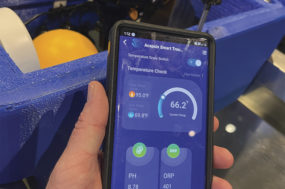Mastitis remains the single-most costly dairy herd health issue in terms of lost productivity, profitability and compromised product quality.
Overall, the dairy industry has made great progress in reducing the average somatic cell count (SCC) on farms, which was reported as 203,000 cells per milliliter in 2016, but what practical significance does this indicate?
An elevated SCC indicates an increased probability a cow may have a mammary infection or mastitis. Mastitis also could be defined as an SCC exceeding a threshold of 200,000 cells per milliliter of milk. The risk of infection is lower when the SCC falls below this threshold and higher when the threshold is exceeded.
Somatic cells compromise immune surveillance cells circulating in the cow’s bloodstream helping to fight infection. At times, bacteria or other pathogens such as yeast break through the cow’s natural physical barriers and colonize the inner lining of the mammary gland to cause infection. The SCC increases as these immune cells respond to fight the infection.
The key to preventing mastitis is to keep teat ends clean and healthy, since the pathogens causing mastitis enter exclusively through the teat orifice. The organisms causing mastitis may be found in the cow’s environment or be spread from cow to cow via milking practices.
Mastitis infection status
Mastitis can be classified as clinical or subclinical. Clinical mastitis is noted by physical changes to the udder, including redness, swelling and heat along with abnormal milk. On the other hand, subclinical mastitis is not reflected by physical changes since the udder and milk still appear normal.
The SCC is used to define subclinical mastitis. Preparation for dealing with new cases of mastitis includes utilizing available tools for early detection and putting a plan into action once cases are detected. These tools can also be used to monitor progress following intervention to determine if the disease process has been cured or converted to another form.
A variety of tools can be used to monitor for and address mastitis given that it can present as either clinical or subclinical. Some of these tools should be incorporated into the daily milking routine.
Visual observation and pre-stripping
As part of the milking routine, milkers should be trained to look for signs of clinical mastitis previously mentioned. Pre-stripping as part of the milking preparation routine not only stimulates the release of oxytocin and milk letdown but also provides an opportunity to observe the milk for signs of clinical mastitis including clots, flakes and discoloration.
A strip cup with a dark background may make these abnormalities easier to spot. Stripping into the hand is not advised because mastitis-causing organisms could easily be transferred from cow to cow. Stripping also should not be done onto bedding where milk from an infected cow could contact other cows.
California Mastitis Test (CMT)
The CMT is a quick, inexpensive tool to be incorporated into the milking prep routine for all cows to monitor for an elevated SCC signaling mastitis, either subclinical or clinical. When this test is performed, cells break down and, as the DNA spills from the cells, it clots.
A greater number of cells will result in more thickening. Instructional videos for using the CMT can be found online. The CMT can be used as a preliminary step in determining which quarter milk samples to culture.
Hand-held devices
There are a variety of hand-held devices that measure electrical conductivity similar to inline monitoring. As the number of somatic cells increase, changes occur in the number of charged particles in the milk, which is recorded as electrical conductivity. Establishing a baseline and monitoring for deviations from this baseline value allow for detection of subclinical mastitis.
For optimized use, this type of tool is better served as part of a normal routine as opposed to an occasional screening test. It is important to distinguish that the output of some devices may be a value other than SCC.
Commercially available rapid tests
A wide array of rapid test kits providing varying degrees of information is commercially available. These kits are useful in detecting subclinical mastitis and may provide information beyond the CMT. Some of these kits can be used to identify specific pathogens or groups of pathogens, useful in taking the next step to determine the appropriate treatment.
When choosing a test, producers should consider the ease of use, throughput of the test, durability of the instruments or components, initial costs along with costs for refills of supplies, desired level of accuracy, ease of interpretation of the test results and training for the milkers who will be using the test.
Records and data
Many dairy producers have a large amount of data from various sources at their disposal. An examination of test data may indicate which cows necessitate closer monitoring. When reviewing records, consider the current lactation as well as the previous lactation. Extension educators and others can assist producers with programs to create reports that can alert producers of cows from which samples may be cultured.
Culturing
On-farm culturing can provide a producer with more information about the pathogen contributing to mastitis. Similar to rapid test kits, culture results serve as a guide in determining the appropriate course of treatment. Producers also can save money by refraining from treating some cases of mastitis with antibiotics. An appropriate intervention can be determined within a day or two to treat mastitis based on culture results.
Supplies and equipment including an incubator, agar plates or one of the commercial film products that contain growth media for micro-organisms, sample tubes, a loop or swabs and other materials along with some basic instruction are needed to get started.
Keep in mind these tools are useful beyond making the initial determination that a cow has mastitis. Tools can be used to continue to monitor cows after a decision is made about treatment to gauge whether the expected outcome was realized from the course chosen.
A case of mastitis can change from subclinical to clinical, clinical to subclinical – or either can be cured. Managing mastitis can be daunting for some producers; however, this may be simplified by having the right tools to detect new cases of mastitis and a plan for treatment. ![]()
Dr. Robert Van Saun is a Penn State University extension veterinarian.

-
Ginger Fenton
- Extension Educator
- Penn State University
- Email Ginger Fenton






